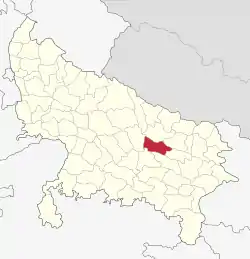Faizabad district
Faizabad district, officially Ayodhya district, is one of the 75 districts of Indian state of Uttar Pradesh. The city of Ayodhya, which is also notable for being the birth place of Hindu deity Rama, is the administrative headquarters of the district.[2][3] The official name of the district was changed from Faizabad to Ayodhya in November 2018 under Uttar Pradesh chief minister Yogi Adityanath.[4] The district occupies an area of 2,764 km² and had a population of 2,470,996 in the 2011 census.
Faizabad district | |
|---|---|
District of Uttar Pradesh | |
| Ayodhya district | |
 Location of Faizabad district in Uttar Pradesh | |
| Country | India |
| State | Uttar Pradesh |
| Division | Faizabad |
| Headquarters | Ayodhya |
| Tehsils | 5 |
| Government | |
| • Lok Sabha constituencies |
|
| • Vidhan Sabha constituencies | |
| Area | |
| • Total | 2,764 km2 (1,067 sq mi) |
| Population (2011)[1] | |
| • Total | 2,470,996 |
| • Density | 890/km2 (2,300/sq mi) |
| • Urban | 689,354 |
| Demographics | |
| • Literacy | 69.57% |
| • Sex ratio | 961 |
| Time zone | UTC+05:30 (IST) |
| Major highways | NH 27, NH 330, National Highway 330A (India), SH 30 |
| Website | http://ayodhya.nic.in |
Demographics
Faizabad district: mother-tongue of population, according to the 2011 Census.[5]
According to the 2011 Indian census, the district had a population of 2,470,996, of which males were 1,259,628 and females were 1,211,368. Population in the age group of 0–6 years was 360,082. This gave it a ranking of 178th in India (out of a total of 640). The district had a population density of 1,054 inhabitants per square kilometre (2,730/sq mi). Its population growth rate over the decade 2001-2011 was 18.16%. The district had a sex ratio of 961 females for every 1000 males. The total number of literates in the district were 1,450,901, which constitutes 58.7% of the population. The effective literacy rate of 7+ population was 70.63%.[1]
At the time of the 2011 Census of India, 96.62% of the population in the district spoke Hindi (or languages considered to be the dialects of Hindi like Awadhi, Banjari, Bhojpuri, Chhattisgarhi, or Garhwali) and 3.14% Urdu as their first language.[5]
| Faizabad district: mother-tongue of population, according to the 2011 Census.[5] | |||
|---|---|---|---|
| Mother tongue code | Mother tongue | People | Percentage |
| 002007 | Bengali | 584 | 0.02% |
| 004001 | Dogri | 831 | 0.03% |
| 006030 | Awadhi | 333,602 | 13.50% |
| 006066 | Banjari | 302 | 0.01% |
| 006102 | Bhojpuri | 804 | 0.03% |
| 006142 | Chhattisgarhi | 788 | 0.03% |
| 006195 | Garhwali | 135 | 0.01% |
| 006240 | Hindi | 2,050,978 | 83.00% |
| 011016 | Malayalam | 182 | 0.01% |
| 015043 | Odia | 557 | 0.02% |
| 016038 | Punjabi | 763 | 0.03% |
| 019014 | Sindhi | 2,432 | 0.10% |
| 022015 | Urdu | 77,484 | 3.14% |
| – | Others | 1,554 | 0.06% |
| Total | 2,470,996 | 100.00% | |
| Year | Pop. | ±% p.a. |
|---|---|---|
| 1901 | 739,402 | — |
| 1911 | 693,018 | −0.65% |
| 1921 | 694,764 | +0.03% |
| 1931 | 714,938 | +0.29% |
| 1941 | 782,639 | +0.91% |
| 1951 | 873,686 | +1.11% |
| 1961 | 960,818 | +0.96% |
| 1971 | 1,107,515 | +1.43% |
| 1981 | 1,361,862 | +2.09% |
| 1991 | 1,684,747 | +2.15% |
| 2001 | 2,088,928 | +2.17% |
| 2011 | 2,470,996 | +1.69% |
| source:[6] | ||
Education
In 1975, Avadh University, later renamed the Dr. Ram Manohar Lohia Avadh University, was established in Faizabad city.
References
- "Census of India: Search Details". www.censusindia.gov.in. Retrieved 6 November 2019.
- "About District | District Ayodhya - Government of Uttar Pradesh". District Ayodhya - Government of Uttar Pradesh. Retrieved 22 November 2019.
- Tully, Mark (2017), India in Slow Motion, Penguin Random House India Private Limited, pp. 18–, ISBN 978-93-5118-097-5
- "Faizabad district to be renamed as Ayodhya, says UP CM Yogi Adityanath". The Financial Express. 6 November 2018. Retrieved 9 November 2019.
- C-16 Population By Mother Tongue – Uttar Pradesh (Report). Office of the Registrar General & Census Commissioner, India. Retrieved 15 July 2020.
- "Census of India Website : Office of the Registrar General & Census Commissioner, India". www.censusindia.gov.in. Retrieved 7 January 2020.
External links
| Wikimedia Commons has media related to Faizabad district. |
| Look up Faizabad in Wiktionary, the free dictionary. |